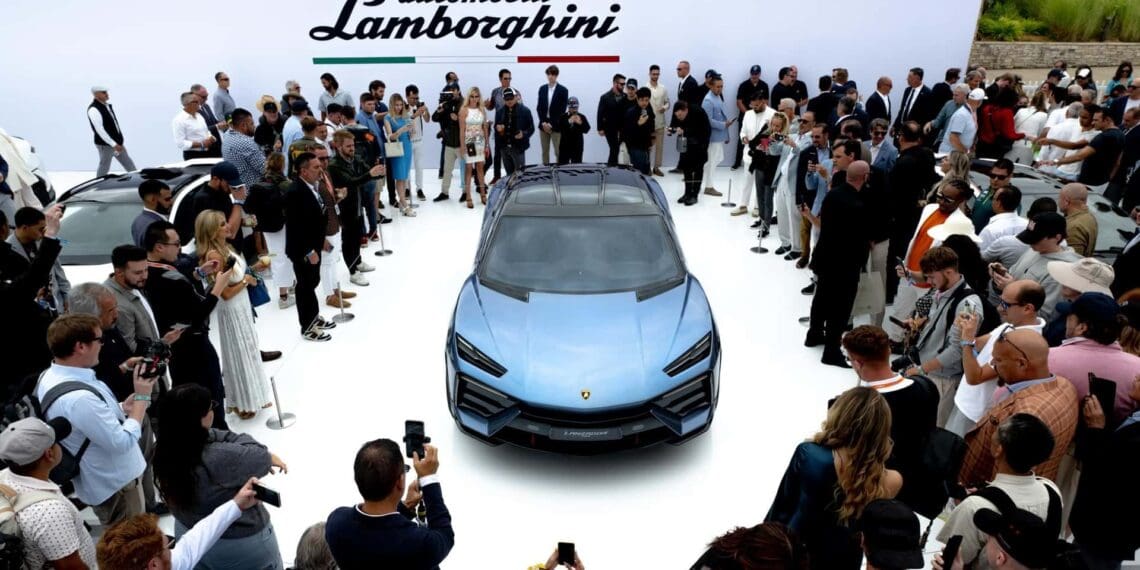While Lamborghini didn’t unveil a new car during this year’s The Quail, A Motorsports Gathering, the Italian carmaker did show off its vision for the future. The Lanzador, named after a fighting bull, is a concept car that depicts what a high-riding, two-door, four-seater, all-electric GT from Lamborghini could look like. Days before its physical debut, however, the brand revealed that a production version is expected to launch by 2028.
I stood in the crowd as the sheet came off, exposing the Lanzador’s shiny blue paint to the Monterey sun, and was treated to a few raw first impressions courtesy of the surrounding attendees. By my account, its reception was mixed. Amongst the thunderous applause, I spotted a few confused faces and overheard a bit of apprehensiveness when its powertrain choice was announced.
A fully electric Lamborghini is a big deal. The Italian supercar manufacturer could be among the first to market with an EV, beating out competitors like Ferrari, McLaren, Maserati, and Aston Martin. The fact that not everyone is on board is expected, and judging by our Instagram comments, some owners seem to be wholly opposed to the idea of an electric Lambo.
With time, I expect these attitudes to change. I suspect that a company like Lamborghini, known mainly for its flamboyant machines, wouldn’t introduce an EV it didn’t feel could match the brand’s DNA. To find out if that’s the case, I caught up with Lamborghini’s Chief Marketing And Sales Officer Federico Foschini after the unveil to dive deeper into the brand’s vision for its first fully electric vehicle, how current customers might embrace it and how it might help Lamborghini reach an all-new portion of the market.
Some responses have been edited for clarity.

What was the main inspiration or idea for the Lanzador?
This is the first Lamborghini electric car. We are doing something that is very much Lamborghini. We are presenting a completely new concept. We are launching an elevated GT 2+2 because we wanted to combine the best of two worlds. On one side, the elegance and performance of a sporty GT, but on the other, we want to provide the comfort and the feeling of safety that a high-positioned car gives you.
We are still doing a car for performance, driving emotion, and design because this is the DNA of Lamborghini. We also need to consider that megatrends are coming, like electrification and digitalization. More and more connectivity, artificial intelligence, and data management will become important points.
A Lamborghini is not normally a commodity; it is something that is a dream, but we’ve learned from the Urus that customers are using these cars as their daily cars. This is something we need to consider. So we think that this kind of concept is an answer for those people who want that kind of usability.
From your perspective, who is the electric Lamborghini customer?
We see an opportunity for people who today already have an SUV and maybe also want a GT. We also see GT owners coming from other brands. People in 6,7 or 8 years, when this car will be on the road, will have different needs than someone today. The typical customer may be a tech forerunner or a businessman who is looking for a very innovative and technological car, one that is very, very digital and connected. I see, for example, an entrepreneur or person who is business-oriented, very wealthy, and can have this car as their main A to B car.
On average, Lamborghini’s customer base is young, ranging from 40 to 45. It’s the youngest among the luxury brands, and I feel they are very much oriented to digitalization, innovation, and connectivity, so this will be a car that takes into account these kinds of people.

Now that potential customers have seen it, what has been some feedback you’ve received thus far?
It was, as expected, incredible. It looks 10 times better live than in pictures. We even had some people, whom I will not name, from other brands, who were enthusiastic, taking pictures and looking at the details. I spoke with dealers, and they’re in love because it’s another step for Lamborghini. For them, it’s going in the right direction. It’s a matter of letting the car be seen.
The second step in the next year is to explain the technology we are going to apply to show what Lamborghini is able to do with an electric car, delivering another level of performance and driving emotion. In 10 years’ time, what the 35-year-olds will want is what the 25-year-olds want today. They pass the day in front of the phone, looking at what’s happening around the world. So we need to take their needs into account, even if it’s a sporty car.
Do you see the car’s connectivity becoming a central selling point in the future alongside its performance?
Yes, I think that we cannot ignore the change. I look at my kids, who are more than 10. Sooner or later, they will be buying a car, maybe not at this price level, but they are living all their life surrounded by entertainment and the ability to be connected. You can’t tell the super connected community that this is a sports car and you don’t need these additional features. Those will become a base you need to provide.
While Lamborghini DNA is one of emotion, performance, and design, you need to guarantee this connectivity for the new customer because there’s a risk they will not select you for this reason, not because they don’t like the car, but because it doesn’t offer the basics. If you go to China, there is always an anticipation of this trend. I have to say, the world is changing.













